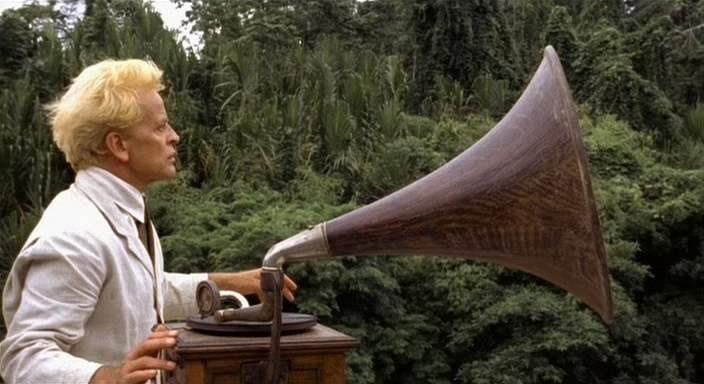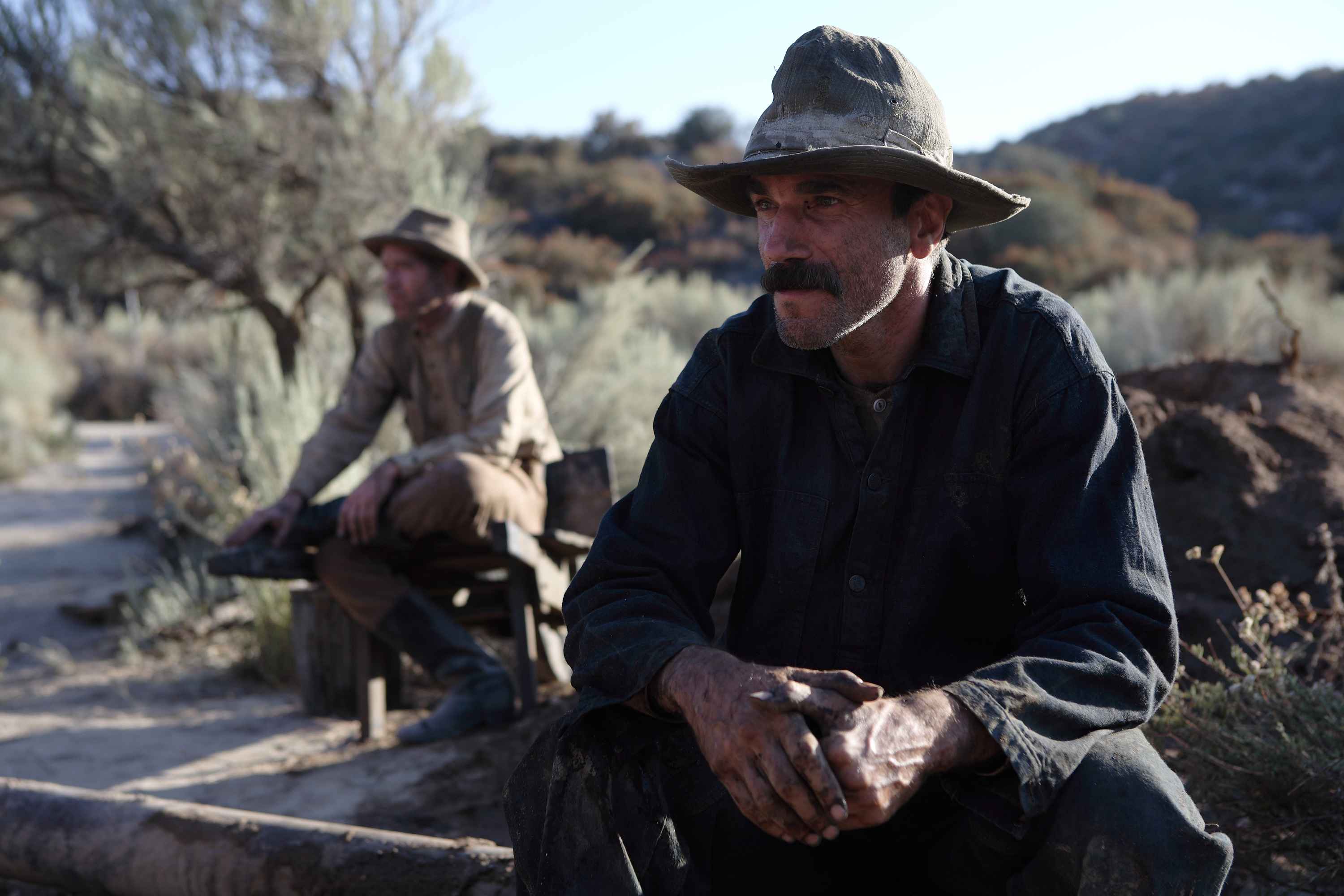What’s difficult about making this list is finding a balance between a successful Kubrickian film that either predates or pays homage to Kubrick and, for lack of a better term, is a ripoff. Now that we’ve hit the apex, it’s clear that these are, regardless of influence, quality films. What sets them apart is their ability to evoke Kubrick’s greatness (or inspire it), while delivering a stand-alone masterpiece. If Kubrick took the helm for any of these films, the result wouldn’t delineate too much. Still. Kubrick is a genius because he always kept us guessing.

10. Fitzcarraldo (1982)
Directed by Werner Herzog
What makes it Kubrickian? It’s a film about extreme obsession and the unreasonable lengths a man will go to when consumed by it. Fitzcarraldo is the story of Brian Sweeny “Fitzcarraldo” Fitzgerald (Klaus Kinski) and his entry into the rubber industry. When he learns that a parcel of land in South America known for its rubber trees remains unclaimed, he decides to investigate, only to find that there is no way to reach the land, as the only tributary is cut off several hundred meters from an Amazon River tributary. His goal: take his massive ship down the tributary and enlist natives to help him manually pull the giant vessel over a muddy hillside to get to the next river. Along the way, they will collect rubber tress and bring it back to Amazon to market. Between Fitzcarraldo, its companion documentary Burden of Dreams, and its companion film, Aguirre: the Wrath of God, the depiction of Kubrickian obsession is more than clear, as Herzog will stop at nothing to have his vision realized, and his protagonist serves as his mouthpiece, however volatile. While the three films paint a much clearer picture, the sheer resolution it took to pull a boat up a mountain, shooting on location, and both the director and Kinski’s single-minded drive is Kubrickian in and of itself.
9. Shame (2011)
Directed by Steve McQueen
What makes it Kubrickian? The camera has an unsettling stillness to it that makes modern New York City feel like a dystopian nightmare. Steve McQueen’s second film took on the touchy subject of sex addiction, as seen through the eyes of Brandon (Michael Fassbender), an advertising executive who finds himself in the throes of a heavy addiction to sex, pornography, and anything else that provides that release. When his estranged sister Sissy (Carey Mulligan) comes to visit, his world is thrown into upheaval, as his carefully concealed secret begins to destroy him. McQueen’s film dives deep into the psychological issues behind the fear of intimacy and the emotional inadequacy of some of the most seemingly confident men, much like Eyes Wide Shut put Tom Cruise in an extremely warped light than audiences were used to (partly the reason for its mixed reception). McQueen and Fassbender are one of the premiere director/actor combos working today and Shame is the most intimate of their work so far. It’s a spotlight on one man, delivering some of those patented Kubrickian stares, as he tries to put the pieces of his broken life back together.

8. La Ronde (1950)
Directed by Max Ophuls
What makes it Kubrickian? Another of Kubrick’s favorite films, La Ronde is a character study meant to focus on the relationships between ten different people – storylines that begin together and move away from each other, all stories about love or, to put it bluntly, sex. Based on the play by Arthur Schintzler, Max Ophüls’ adaptation is told from the viewpoint of a conversationalist as he walks us through a series of affairs, each leading on to the next. Some are love stories, some are not. But each has an effect on the other moving forward. While not typically a topic Kubrick would dissect, what makes it Kubrickian is the stylistic approach to the topic. Ophüls has garnered similar criticisms as Kubrick – many view his work as simply an apophasis, lacking deeper substance by never talking about an actual theme. The fact that there is a Kubrickian style points to that, but, like Ophüls, his films manage to stand out for their creative narrative structure. La Ronde is probably his most interesting story, with the feminine touch Ophüls tends to infuse. La Ronde is not his best film, but in terms of influencing another master, it’s probably his best example of using narrative space to tell stories about romance that lean more toward loss and regret than anything. Kubrick’s protagonists have long been isolated characters looking for something – passion, love, even pain.
 7. Eraserhead (1977)
7. Eraserhead (1977)
Directed by David Lynch
What makes it Kubrickian? A black-and-white surrealist body horror film, Eraserhead is David Lynch’s first full-length feature, a dirty allegory about the fear of parenthood. Starring Jack Nance as Henry Spencer, an interesting-looking man whose head is apparently a micro-planet. He awkwardly romances the beautiful girl across the hall (Judith Anna Roberts) and she gets pregnant, eventually birthing an inhuman-looking baby with a reptilian head that resembles a spermatozoan-style creature that emerges from Harry’s mouth early in the film. It’s not an easy sit. If Kubrick’s films are representations of larger themes, Eraserhead is an insanely-minded metaphor meant to disturb the viewers, while trying to bring about deeper questions without any real pretense. Kubrick has used black-and-white photography in the past to give his films a stark feel – Lynch does the same here, the cinematography creating a dream-like world that is more of nightmare. Kubrick has made disturbing films: A Clockwork Orange is twisted; Eyes Wide Shut jumps to sexual themes that hadn’t been approached so vividly before. Eraserhead (and other Lynch films) steamrolls through any attempt at subtlety by putting his own subconscious fears on screen without regard for the viewer. If Kubrick is a master architect of black themes, Lynch is the understudy who loses his mind after years of toiling under his supervisor, only to become a criminal mastermind.
 6. Pan’s Labyrinth (2006)
6. Pan’s Labyrinth (2006)
Directed by Guillermo del Toro
What makes it Kubrickian? It’s kind of like The Shining if Danny was the hero. And not a horror film. Pan’s Labyrinth is the story of young Ofelia (Ivana Baquero), living in post Civil War Spain with her mother and stepfather, an anti-Franco commander assigned to conquer rebels. Her mother is pregnant, and Ofelia wants nothing more than for her to be safe. When she discovers a tiny creature she believes is a fairy, she finds herself pulled into a fantastical world of mythical creatures that give her tasks to carry out if she wishes to save her unborn brother and escape the world of pain she is sure to endure with her stepfather. Del Toro’s design of both worlds – the real and the fantasy – are so incredibly imagined and detailed, visually and metaphorically. The monsters in the fantasy world feel more real than the monster (Ofelia’s stepfather) in the real world most times. Taking a Kubrickian cue, del Toro cast Doug Jones as both the faun (Pan) and the Pale Man (much like Peter Sellers’ multiple roles in Dr. Strangelove), the most striking monster from the film and the image most associated with this fairy tale. Pan’s Labyrinth takes a childlike topic – a story about a fairy princess – and puts a real-world spin on it, creating a dark and beautiful parable. All this, plus a literal chase through a hedge maze where Ofelia is running from her stepfather make the film indelibly Kubrickian, but also a wholly original story of triumph and beauty in a world of sadness.
 5. Picnic at Hanging Rock (1975)
5. Picnic at Hanging Rock (1975)
Directed by Peter Weir
What makes it Kubrickian? On the surface, it doesn’t look entirely Kubrickian. But feel it. Among the idyllic beauty Peter Weir puts on screen is a dark underbelly of mystique and terror. Picnic at Hanging Rock is based on Joan Lindsay’s novel, which, in turn, was based on the true story of the disappearance of schoolgirls at Hanging Rock in Australia, Valentine’s Day 1900. It’s not necessarily a psychological study, but it is an exercise in frustration. Much like 2001, nothing is solved. What happened to these girls? In Weir’s mind, it doesn’t really matter. Instead, his masterpiece is littered with striking imagery and a slow-burn narrative structure that only gives viewers a taste of what is lurking behind both these girls and their teacher. It’s much prettier than Kubrick’s films, for sure. But stylistically, that impending fear and isolation is still there, clear as day. While Kubrick’s version would probably give more hints as to what may have happened, there’s no question he would have left those as mere possibilities. Weir does the same, but in a manner that is so beautifully unclear that the mystery of the film ends up on the fringes as we are taken into the gorgeous method in which Weir delivers his cliffhanger (pun intended).
 4. Blade Runner (1982)
4. Blade Runner (1982)
Directed by Ridley Scott
What makes it Kubrickian? First, Douglas Trumbull did the special effects for Ridley Scott’s film, as well as 2001: A Space Odyssey. Second, despite the performances being necessary to the success of this sci-fi/noir, the world itself is the star of the film. Blade Runner is the story of Rick Deckard (Harrison Ford), tasked with finding genetically engineers robots called replicants, who were built by a mega-corporation to do off-planet work at various colonies, and have since escaped and returned to Earth. Deckard works in 2019 Los Angeles, shown as a black-rain dystopia, searching for these replicants, namely Zhora (Daryl Hannah) and Roy (Rutger Hauer). Meanwhile, he is befriended by an experimental replicant named Rachael (Sean Young) who believes she is human. Based on a Philip K. Dick novel, Blade Runner‘s world is incredibly driven by machinery and technology, much like the world of 2001. Its central theme is the individuality of these machines – as Dick’s source novel’s title states, do androids dream of electric sheep? Do robots have consciousness? If they do, what’s to stop them from exercising their decision-making prowess and fighting back? While 2001 asks those questions in a more philosophical manner, Blade Runner blends them in to one of the best science-fiction films of the last 35 years; it’s an action movie for the thinking person.
 3. Metropolis (1927)
3. Metropolis (1927)
Directed by Fritz Lang
What makes it Kubrickian? It’s the first true science-fiction feature film. Without it, we may not have 2001. Or Dr. Strangelove. Or A Clockwork Orange. On top of that, it’s a criticism of class and economy. The first forecast of a dystopian future came from Fritz Lang’s 1927 masterpiece Metropolis, a futuristic tale of class warfare as Freder (Gustav Fröhlich), son of the master of the city, decides to close the gap between the rich and the poor after meeting Maria (Brigitte Helm). When he begins to learn the horrors of the working class, as well as finding mysterious maps on the bodies of dead workers in his father’s machine rooms, he and Maria begin to unravel the mystery of what is under Metropolis, with the help of an inventor named Rotwang (Rudolph Klein-Rogge) and his Machine-Human (also Helm), modeled after the love of his life – Freder’s mother – who left him to marry Freder’s father and died giving birth to Freder. It’s really an art-deco film, with settings modeled after New York City skyscrapers and European architecture. But, most importantly, it’s about the struggle between progress and ethos, industry and emotion. Metropolis will only truly be a happy place if the intelligence used to build it partners with the love of the people who inhabit it. It’s the first attempt to discuss the dangers of technology taking over and replacing human life, while at the same time predicting the wonders that could come from it. Finally – 2001: A Space Odyssey was set in 2001 as homage to Metropolis: one year after Lang’s film was set, as it was one of Kubrick’s favorite science-fiction films.
2. There Will Be Blood (2007)
Directed by Paul Thomas Anderson
What makes it Kubrickian? In the past 10 years, this is the film that lives, breathes, and sleeps Stanley Kubrick. Paul Thomas Anderson’s previous work was deftly influenced by Robert Altman more than most, but in 2007, his masterpiece (so far) was on display: There Will Be Blood. Starring Oscar winner Daniel Day-Lewis as Daniel Plainview, a ruthless oil baron, the film is a fable about, again, obsession and the need for power. Moment to moment, there are clear Kubrick influences. The uncomfortable score that doesn’t seem to have a flow, courtesy of Jonny Greenwood. That long, hollow bowling alley in the basement of Plainview’s estate. The camera angles, both intimate and panoramic. There are stand-alone scenes with clear homages to Kubrick’s 2001, most memorably Plainview’s final act – the ape finally exercising his physical strength, changing the course of history. The storylines of Blood and 2001 couldn’t be further from each other, but There Will Be Blood is the same story as 2001: the evolution of man to a soulless shell, trapped in an isolated, well-decorated room in space. Plainview’s mansion is his end game: like Dave Bowman; like Jack Torrance. He’s finished. We all are.

1. Solaris (1972)
Directed by Andrei Tarkovsky
What makes it Kubrickian? It’s basically the Russian answer to 2001: A Space Odyssey. Andrei Tarkovsky’s brilliant adaptation of the 1961 novel of the same name takes us into space as well, to discuss how we define ourselves through our relationships (or lack thereof). Kris Kelvin (Donatas Banionis) is sent to the Solaris Station, knowing that he will not return for a long time, leading him to destroy dozens of personal items before leaving. The friend he thought he had on the ship has committed suicide; the other scientists are not helpful. One night, exhausted, Kelvin is visited by a woman who appears to be his wife Hari (Natalya Bondarchuk), who committed suicide 10 years earlier. Solaris the planet seems to be creating matter based on Kelvin’s memories. His embrace of his long lost wife seems to be affecting the surface of Solaris, too, as islands begin to appear on the planet normally engulfed in frozen waters. From there, it’s a struggle between what is real and what is imagined – if Hari is real, can he live in his memories forever on Solaris? If not, will his rejection of her destroy the planet? It’s a much more character-driven, emotional story than 2001 (Steven Soderbergh’s 2002 remake is actually more Kubrickian with its camerawork and narrative structure; although a good film, it still falls short of this original), but it still wrestles with those philosophical questions posed in science-fiction art films like these. Our purpose on this planet may be simply to exist – to communicate with each other, love, and move forward. Solaris doesn’t paint a clear picture, but warns us of the danger of memories and how we move on. Regret and depression are dangerous side effects of intense memory. The monoliths, Solaris – they may be links to our past, but may also be links to our future. The questions is, do we want them to be?
— Joshua Gaul








